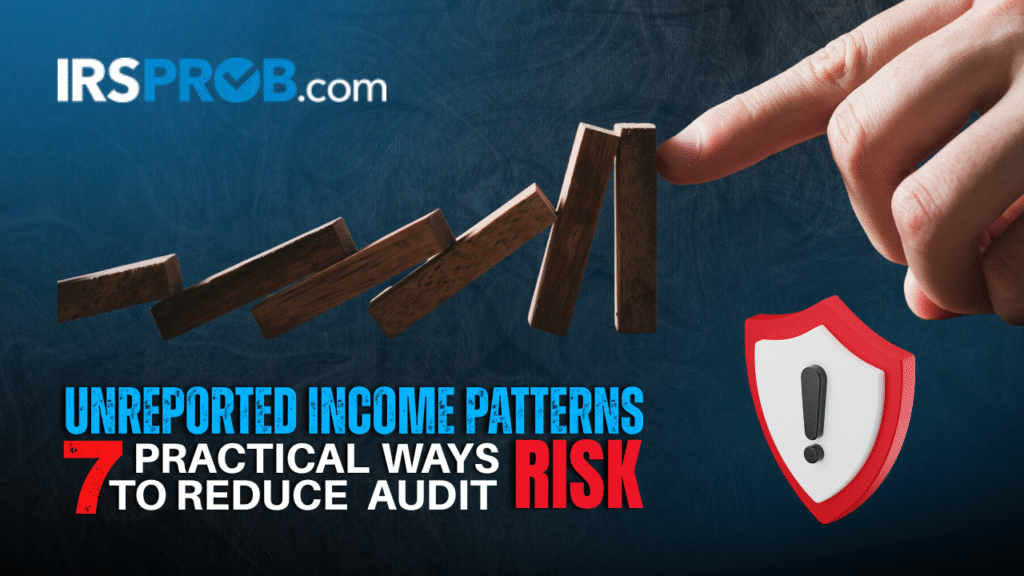
If I told you that $696 billion in taxes went unpaid for a single year, would you assume it was all scams and shell companies? The reality is more ordinary and more revealing. Much of the gap is tied to unreported income patterns that emerge when deductions run high and income is hard to see. Understanding those patterns can save you money, time, and stress.
Why is it Important?
The IRS measures the "tax gap" to show the difference between taxes owed and taxes paid on time. For Tax Year 2022, the gross tax gap was $696 billion, with a voluntary compliance rate of 85.0%. Those figures aren't abstract. They signal where enforcement is headed and which behaviors carry risk. Unreported income patterns sit at the center of that story.
The Data Behind This
Statistical analysis shows compliance rises with visibility. Wages with withholding and third party reporting show about 1% misreporting. Income with substantial reporting but no withholding shows 6%. Income with little or no reporting, like many sole proprietorships, shows 55% misreporting. This visibility lens is the simplest way to see unreported income patterns before they become problems.
The Patterns and High Deductions Go Together
Where do high deductions fit? In 2022 projections, individual income underreporting made up $381 billion, and the biggest slice came from items with little or no information reporting. Within that slice, nonfarm proprietor income alone accounted for $117 billion of the gross gap. If your deductions dramatically shrink your profits compared with peers, that outlier profile is the essence of unreported income patterns.
Unreported Income Patterns and the IRS Selection Playbook
Returns aren't picked at random. The IRS uses computerized scoring like DIF and UIDIF to identify returns with higher potential for change or unreported income. The formulas are not public and scores are shielded from disclosure, but their purpose is clear: find outliers. If your return looks very different from statistical norms, it is more likely to be looked at. That is how unreported income patterns move from data to action.
Unreported Income Patterns in Cash heavy Businesses
Think of a cash heavy business as a river with many side streams. Money can bypass the main channel, which makes measurement tricky. IRS examiners use bank deposit and cash expenditures methods to reconstruct true income when unreported income patterns are likely. If your business is cash intensive, the quality of your records is not optional. It is your first and best defense.
Story: Unreported Income Patterns in Real Life
Maya runs a design studio. In 2022 her receipts grew 10 percent, but her deductions jumped 25 percent. Her profit margin fell below industry norms at the same time that many sole proprietors reported rising receipts and rising deductions with largely flat profits overall. On paper, Maya's year looked like a cliff. That is a classic shape for unreported income patterns. She tightened recordkeeping, separated personal and business spending, logged vehicle and home office use, and mapped expenses to client work. The next year, her margin returned to normal and her documentation closed the loop.
Analogy: The Speed Camera for Taxes
Imagine a highway with a speed camera. Most cars go 60. If you pass at 100, you stand out. Unreported income patterns are the equivalent of speeding. The "camera" is the IRS's mix of information matching, analytics, and audit techniques. W 2s and 1099s are license plates. The system compares what others report about you to what you report about yourself. Mismatches and outlier ratios get a closer look.
7 Practical Ways to Reduce Risk From Unreported Income Patterns
Use these steps to make your numbers align with reality and withstand scrutiny.
1. Benchmark your profit and deductions
Compare your expense and profit ratios to IRS Statistics of Income tables for your industry so you know when you are drifting into unreported income patterns.
2. Document high impact deductions
Keep contemporaneous logs for vehicle, travel, meals, and home office. Use the latest IRS guidance for travel rules before you claim. This turns potential unreported income patterns into well supported entries.
3. Tie deductions to revenue
When deductions jump faster than revenue, write a short memo linking major expenses to projects or growth plans. This simple narrative clarifies patterns that otherwise look like unreported income patterns.
4. Reconcile all information returns
Match every 1099 and W 2 to your return before filing. Information matching is the fastest way the IRS finds unreported income patterns.
5. Mind cash flow evidence
If you handle cash, make bank deposits consistently and keep petty cash logs. These habits counter the very methods examiners use when unreported income patterns are suspected.
6. Watch Schedule C loss years
Chronic losses, or a sudden swing to a very low margin, can mimic unreported income patterns. Pair any unusual year with airtight records and clear business purpose. Findings from IRS research show that Schedule C is a major source of detected under reporting.
7. Review before you file
Do a "visibility check." Ask whether most of your income is covered by third party reporting. If not, assume higher scrutiny and prepare documentation that neutralizes unreported income patterns at the source.

Key Points Regarding Patterns of unreported Income
The numbers are clear. Under reporting dominates the tax gap, and it is concentrated where income is hard to see and deductions are large relative to peers. The IRS's strategy reflects that reality, from information matching to analytics to targeted techniques for cash businesses. When you keep your records clean, benchmark your ratios, and connect deductions to business purpose, you turn unreported income patterns into a compliant, credible story.
Open last year's return. Calculate your profit margin and your biggest deduction categories. Compare them with IRS industry tables. If anything looks like unreported income patterns, add documentation now and adjust your 2025 plan before tax season starts. Your future self will thank you.
Notes on Sources and Data Integrity
IRS Tax Gap Projections are projections that rely on the most recent completed compliance data and estimation methods such as Detection Controlled Estimation; they are the agency's current best view and are updated as new data become available.
The IRS working paper on Tax Evasion at the Top uses micro data and explains why detected evasion may be lower at the very top if sophisticated strategies elude standard audits. It also documents the large role of Schedule C in detected under reporting.
Need Help With Your Tax Documentation?
If you're concerned about unreported income patterns in your business or want to ensure your deductions are properly documented, professional guidance can make all the difference.
Learn More





